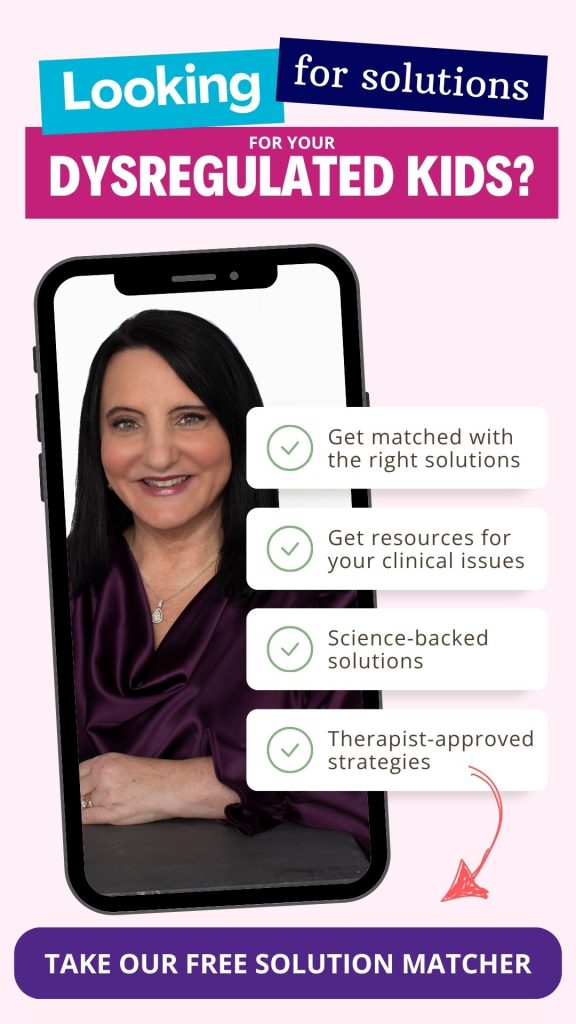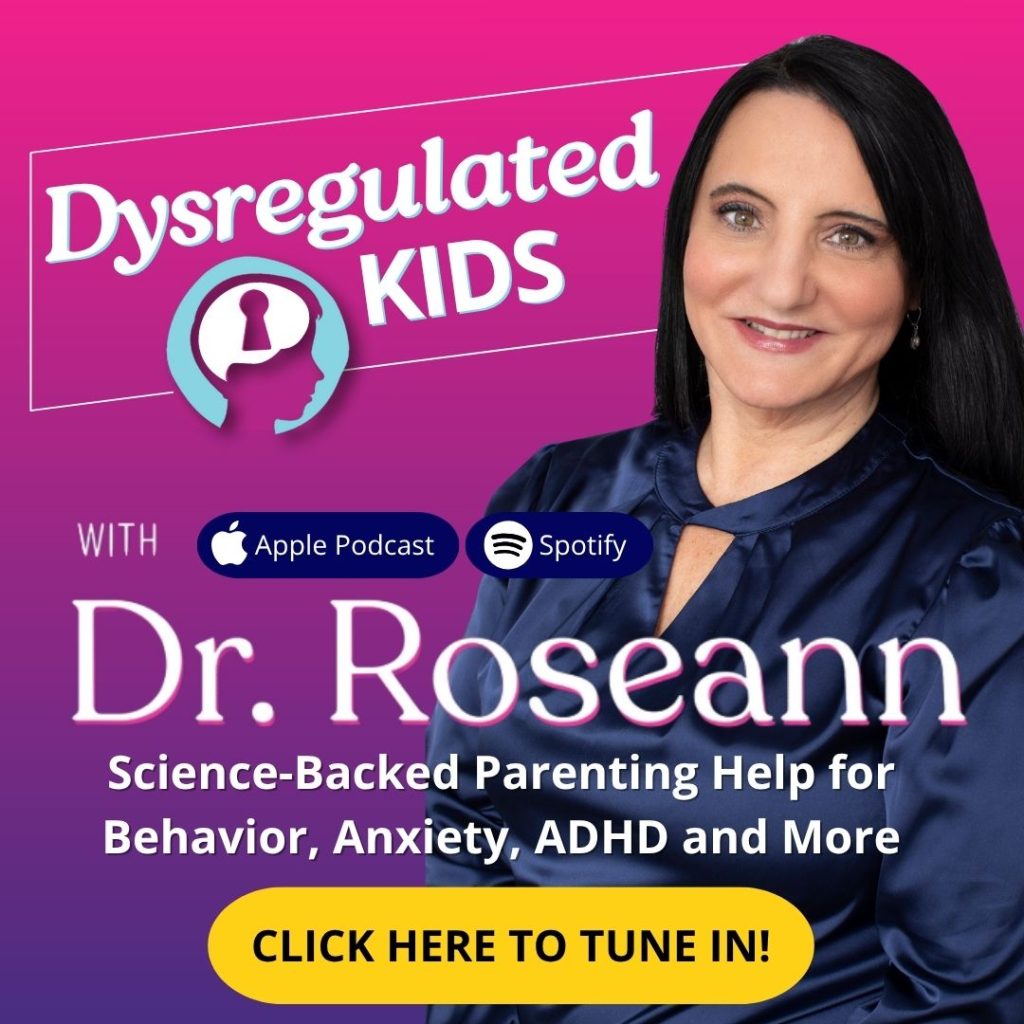Estimated reading time: 11 minutes
Even when you think you’ve done everything—routines, therapy, patience—it can still feel like you’re walking on eggshells as your child battles worry, big emotions, or focus issues.
What many parents don’t realize at first is this: What looks like misbehavior is often a dysregulated brain doing its best to cope, and real healing starts when we calm the brain first.
Why Does Your Child Get Stuck In A Cycle of Dysregulation?
More children than ever are trapped in a cycle of nervous system dysregulation. Their brains are:
- Overactive – constantly “on,” even when they’re supposed to be resting.
- Overstimulated – flooded by sensory input and emotional stress.
- Unable to reset – stuck in fight, flight, or freeze, without knowing how to shift out of it.
When this happens, everything is affected:
- Emotions become explosive or unpredictable
- Behavior spirals, often mistaken for defiance
- Learning gets harder
- Connection with family, teachers, and friends breaks down
That’s where neurofeedback comes in.
What is Neurofeedback?
Neurofeedback is a gentle, drug-free therapy that mainly trains the brain to self-regulate.
Here’s what it does:
- Provides real-time feedback on brainwave activity
- Trains the brain to self-regulate
- Helps the nervous system shift from dysregulated to calm
- Builds resilience to stress and emotional triggers
- Improves focus, mood, and emotional control
And yes—it’s backed by science. Thousands of studies show how neurofeedback supports kids with:
- ADHD
- OCD
- PANS/PANDAS
- Anxiety
- Mood and behavioral challenges
And remember—what you usually see as bad behavior is really brain dysregulation. Let’s start by helping the brain do its job.
What Brain Waves Does Neurofeedback Target?
Neurofeedback is a safe, non-invasive therapy that helps the brain self-regulate by tuning brain wave activity in real time.
At our Connecticut neurofeedback center, we offer both in-person sessions and virtual, at-home neurofeedback programs—because every brain deserves the chance to reset and thrive.
| Brain Wave | Role in Brain Function | When Helpful For |
|---|---|---|
| Alpha | Supports relaxation | Anxiety, OCD |
| Beta | Enhances focus and alertness | ADHD |
| Theta | Connected to creativity and emotional processing | Depression, PTSD (when dysregulated) |
| Delta | Promotes deep sleep | Insomnia, mood disorders |
Most Common Conditions Neurofeedback Treats
Neurofeedback helps regulate the nervous system for all ages—leading to lasting improvements in mood, focus, and behavior. At our center, we use it to treat a number of clinical conditions in-person and at home.
Here are the top 7 conditions neurofeedback helps most:

1. ADHD (Attention Deficit Hyperactivity Disorder)
ADHD affects 9.4% of children aged 2–17 in the U.S. (~6.1 million), and 7.4% have a diagnosed behavior disorder (~4.5 million) (CDC, 2021).
Unfortunately, 1 in 5 kids with ADHD don’t receive the school-based interventions they need, making learning and social interactions harder (DuPaul et al., 2018).
The neuroscience of ADHD shows us that the brain often has:
- Too many unfocused brainwaves – which leads to daydreaming, mental drifting, and difficulty staying engaged.
- Not enough focused brainwaves – which are essential for alertness, sustained attention, and completing low-interest or multi-step tasks.
When a child’s brain isn’t producing the right mix of brainwaves, you may see:
- Trouble following instructions
- Difficulty shifting from one task to another
- Impulsivity and poor self-control
- Struggles with task completion
The brain has to be alert and organized to handle these demands successfully. That’s where neurofeedback becomes a game-changer.
Neurofeedback works by calming an overstimulated brain and balancing attention-related brainwaves (Chiu et al., 2022).
It improves:
- Attention and focus
- Task initiation and completion
- Emotional regulation
- Impulse control
2. Executive Functioning Issues
Executive dysfunction often co-occurs with ADHD, autism, anxiety, and other conditions.
Neurofeedback calms the brain, which is the foundation needed before any new executive functioning skills can be learned. It has also been shown to improve the executive functioning of children with ADHD and autism (Kouijzer et al., 2009).
A 2024 study targeting the left dorsolateral prefrontal cortex found significant improvements in executive function in individuals with autism (Pereira et al., 2024), just as we see in our BrainBehaviorReset™ Program.
Gains include:
- Task organization
- Cognitive flexibility
- Working memory
- Planning and decision-making
3. Anxiety Disorders
Chronic anxiety keeps the nervous system stuck in a hyperactive “on” state.
The good news? Neurofeedback reduces physical and emotional symptoms by helping the brain shift into a regulated state.
A 2022 study showed neurofeedback was highly effective for children with Generalized Anxiety Disorder (GAD), with strong gains in state anxiety compared to CBT (Salama et al., 2022).
Neurofeedback helps reduce:
- Racing thoughts
- Sleep disturbances
- Emotional reactivity
- Physical symptoms like stomachaches and headaches
4. Obsessive Compulsive Disorder (OCD)
There are many myths about OCD, but the one that gets in the way of people really getting help is not understanding what OCD really looks like. It often goes undiagnosed due to the internal nature of intrusive thoughts.
At our center, we specialize in OCD and PANS/PANDAS and pair neurofeedback with ERP therapy to retrain the brain and reduce compulsions.
How Neurofeedback Works:
- Calms overactive brainwave patterns
- Increases ability to manage intrusive thoughts
- Improves response to ERP and behavioral therapy
5. Depression
Depression can stem from many sources and like anxiety and OCD, it often flies under the radar. But there are two broad symptom patterns to look out for:
- Internalizing behaviors (often seen in “quiet strugglers”):
- Withdrawal from friends or family
- Low motivation or energy
- Fatigue and oversleeping
- Poor hygiene or self-care
- Tearfulness or sadness that comes “out of nowhere”
- Externalizing behaviors (more common in “acting out” kids):
- Irritability or crankiness
- Frequent anger or emotional outbursts
- Mood swings or emotional lability
- Aggression or defiance
Children with these symptoms often have overlapping diagnoses such as:
- ADHD
- Anxiety
- Oppositional Defiant Disorder (ODD)
How Neurofeedback Helps with Depression:
- Mood stability
- Alertness
- Motivation
- Outlook on life
It’s especially effective for depression caused by:
- Chronic stress or anxiety
- Genetic predisposition
- Chronic pain or inflammation
- Neurological or developmental conditions
6. Chronic Illness and Autoimmune Disorders (PANS/PANDAS, Lyme Disease)
The U.S. National Health and Nutrition Examination Survey (NHANES) revealed a troubling trend: autoimmune conditions are rising, especially in teens.
The 2023 study found that the prevalence of the most common biomarker of autoimmunity—antinuclear antibodies (ANA)—is significantly increasing. Among adolescents ages 12–19, ANA levels tripled during the study period.
These illnesses often come with co-occurring mental health symptoms due to inflammation affecting the brain. Here are some clinical conditions linked to inflammation:
- Anxiety
- Depression
- Obsessive-Compulsive Disorder (OCD)
- PANS/PANDAS
- Autism
- Chronic pain
- Post-concussion syndrome
The good news is that reducing inflammation often leads to symptom relief—and neurofeedback can help the body reach that calm, healing state.
How Neurofeedback Helps Children With Chronic Conditions
Neurofeedback calms the central nervous system, shifting it from a sympathetic dominant state (fight-or-flight) to a parasympathetic state (rest-and-digest). This shift:
- Allows the body to redirect resources from survival mode to healing mode
- Regulates immune function, hormones, and neurotransmitters
- Supports nutrient absorption and energy balance
- Creates the neurological calm needed to restore cognitive and emotional regulation
This shift is essential in chronic illnesses, including:
- PANS/PANDAS
- Lyme Disease
- Tick-borne illnesses
- Other chronic inflammatory or autoimmune conditions
The field of psychoimmunology shows that when the body is in a prolonged stress state, it can’t properly respond to infections or regulate its immune response.
Stress hijacks healing—diverting immune, hormonal, and neurological resources toward crisis control instead of recovery.
This is exactly why so many with autoimmune conditions struggle to get better. But here’s your next “aha” moment: When you calm the brain and body, you activate the body’s natural healing abilities.
At our center, we use neurofeedback to support children and teens with PANS/PANDAS, Lyme Disease, and related conditions.
Through our customized programs, we help them calm their nervous system, reduce inflammation, and finally begin the path toward healing.
7. Learning and Memory Challenges
I’ve experienced firsthand how neurofeedback can dramatically enhance learning and memory. The boost in how quickly I process information is honestly hard to describe.
I often tell the kids I work with that it’s like being Quicksilver from the X-Men movies—my brain feels like it’s operating in fast-forward while the world moves in slow motion.
To be fair, I started with a solid foundation, but neurofeedback took my cognitive performance to a whole new level—ten levels higher, in fact!
For many children, though, learning isn’t so easy—especially those with clinical conditions like:
- Dyslexia
- ADHD
- Learning disabilities
These challenges are often linked to poor communication between different parts of the brain.
Neurofeedback helps by:
- Improving brainwave communication – making brain signaling faster and more efficient
- Enhancing neurological function – strengthening the brain structures responsible for memory and learning
- Boosting specific learning skills – such as:
- Phoneme processing (especially important for children with dyslexia)
- Working memory
- Reading fluency and comprehension
These aren’t small wins—they’re life-changing skills that directly impact classroom success and long-term academic outcomes.
At our center, every child receives a customized care plan through my BrainBehaviorReset™ Program, which includes:
- Personalized neurofeedback protocols
- Exclusive 1-on-1 sessions with me or a member of my expert integrative mental health team
- Targeted support for cognitive, emotional, and behavioral goals
And here’s something every parent should know: Your child doesn’t need a diagnosis to benefit from neurofeedback. If they’re struggling with focus, learning, or emotional regulation—and they simply want to feel better—neurofeedback can help.
Because when the brain is functioning at its best:
- Focus improves
- Memory sharpens
- Emotional regulation strengthens
- Learning becomes easier
- Confidence grows
And most importantly—your child can finally thrive.
Parent Action Steps
FAQs
How does neurofeedback affect the brain?
Neurofeedback trains the brain to produce healthier brainwave patterns. Over time, this rewiring helps improve brain communication, increase flexibility and efficiency, and restore emotional and behavioral balance.
What are the benefits of neurofeedback?
Neurofeedback helps improve attention, focus, mood regulation, impulse control, sleep, and cognitive performance. It also supports nervous system regulation, which reduces symptoms tied to anxiety, depression, OCD, and chronic illness.
Who should use neurofeedback?
Neurofeedback is beneficial for children, teens, and adults struggling with issues like ADHD, anxiety, executive dysfunction, mood disorders, learning challenges, or chronic conditions such as PANS/PANDAS and Lyme Disease.
Does neurofeedback work permanently?
For most individuals, neurofeedback leads to long-lasting improvements—especially when paired with healthy lifestyle habits and continued skill use. The brain learns to self-regulate, which can hold even after sessions end.
Citations:
Centers for Disease Control and Prevention. (n.d.). Data and statistics about ADHD. U.S. Department of Health & Human Services. Retrieved March 6, 2025, from https://www.cdc.gov/adhd/data/index.html
Chiu, H-J., Sun, C-K., Fan, H-Y., Tzang, R-F., Wang, M-Y., Cheng, Y-C., Cheng, Y-S., Yeh, P-Y., and Chung, W. (2022). Surface electroencephalographic neurofeedback improves sustained attention in ADHD: a meta analysis of randomized controlled trials. Child and Adolescent Psychiatry and Mental Health 16(104). https://doi.org/10.1186/s13034-022-00543-1
DuPaul G. J. (2018). Promoting Success Across School Years for Children With Attention-Deficit/Hyperactivity Disorder: Collaborative School-Home Intervention. Journal of the American Academy of Child and Adolescent Psychiatry, 57(4), 231–232. https://doi.org/10.1016/j.jaac.2018.02.001
Kouijzer, M., de Moor, J., Gerrits, B., Buitelaar, J., and van Schie, H. (2009). Long-term effects of neurofeedback treatment in autism. Research in Autism Spectrum Disorders 3(2):496-501. https://doi.org/10.1016/j.rasd.2008.10.003
National Institutes of Health. (2023). Autoimmunity may be rising in the United States. U.S. Department of Health & Human Services. Retrieved March 6, 2025, from https://www.nih.gov/news-events/news-releases/autoimmunity-may-be-rising-united-states
Pereira, D.J., Morais, S., Sayal, A., Pereira, J., Meneses, S., Areias, G., Direito, B., Macedo, A., and Branco, M. (2024). Neurofeedback training of executive function in autism spectrum disorder: distinct effects on brain activity levels and compensatory connectivity changes. J Neurodevelop Disord 16(14). https://doi.org/10.1186/s11689-024-09531-2
Salama, A., Abdel-Latif, S., Omar, T., El Wafa, H.A. (2022). Neurofeedback training and cognitive behavior therapy for treatment of Generalized Anxiety Disorder in children and adolescents: a comparative study. NeuroRegulation 9:1. https://doi.org/10.15540/nr.9.1.29
Dr. Roseann is a mental health expert in neurofeedback who frequently is in the media:
- The Holistic Counseling Podcast Therapist’s Integrative Tools: Neurofeedback and Biofeedback
- Life’s Essential Ingredients Connecting at the Root
- Helping Children Thrive Podcast Benefits of Neurofeedback for children with ADHD
- It’s Gonna Be OK! With Dr. Roseann Podcast: Neurofeedback Series
- Mel Robbins Show: Neurofeedback
- Clearly Clinical Podcast: Neurofeedback
- Creative Clinician’s Corner: Neurofeedback
Always remember… “Calm Brain, Happy Family™”
Disclaimer: This article is not intended to give health advice and it is recommended to consult with a physician before beginning any new wellness regime. *The effectiveness of diagnosis and treatment vary by patient and condition. Dr. Roseann Capanna-Hodge, LLC does not guarantee certain results.
Are you looking for SOLUTIONS for your struggling child or teen?
Dr. Roseann and her team are all about science-backed solutions, so you are in the right place!
Grab your complementary copy of the











